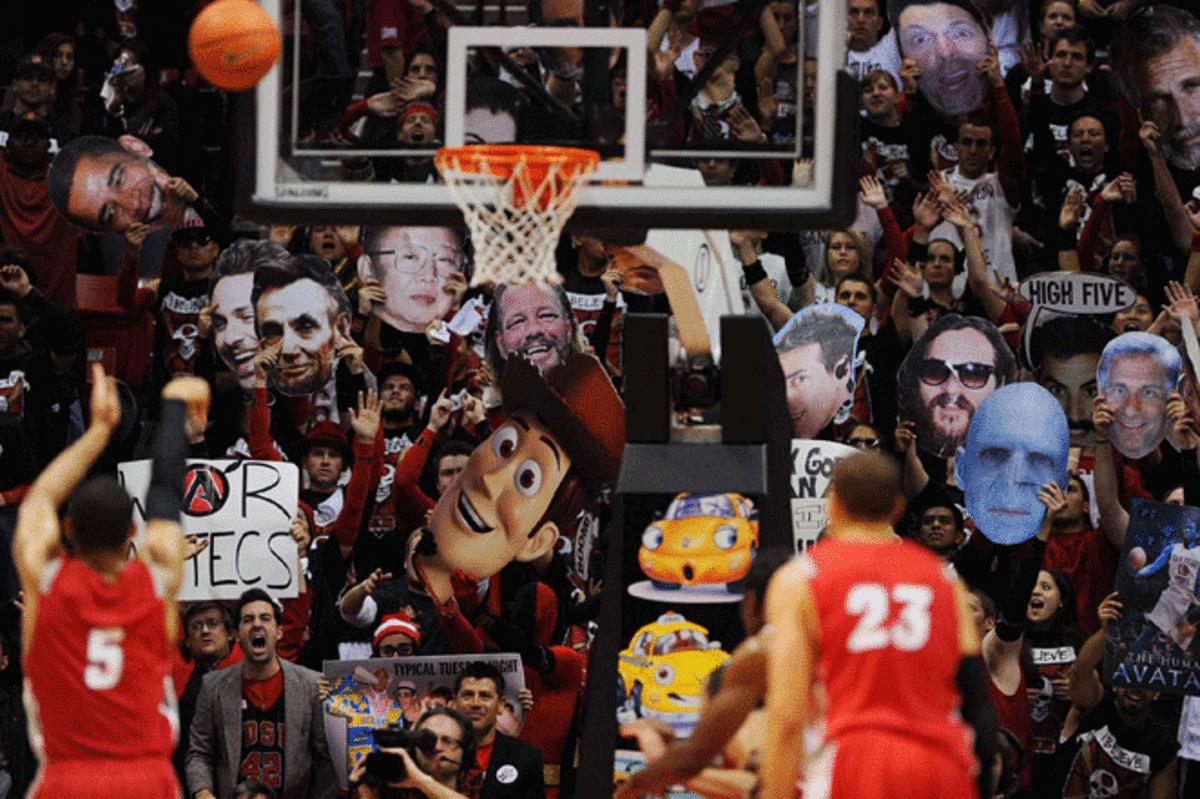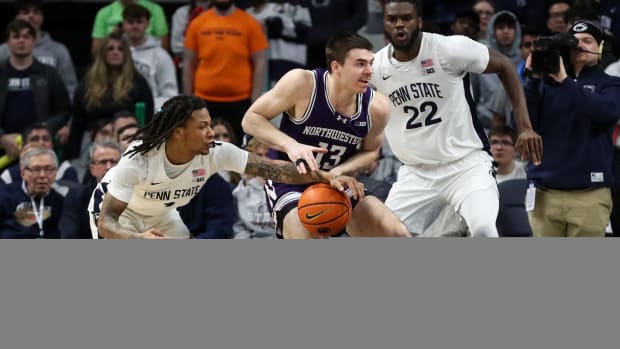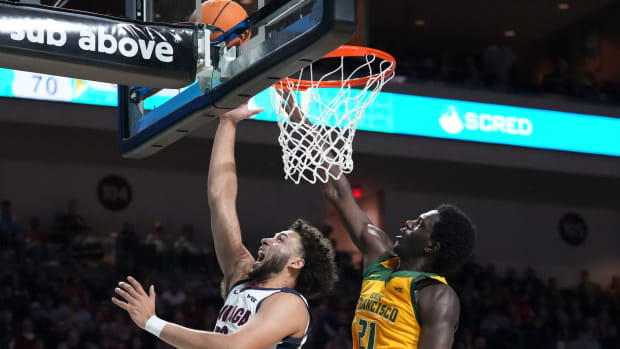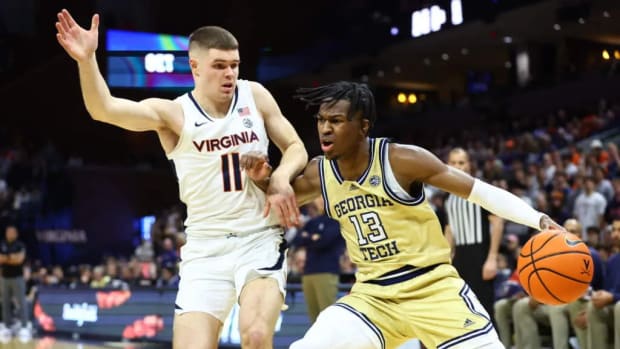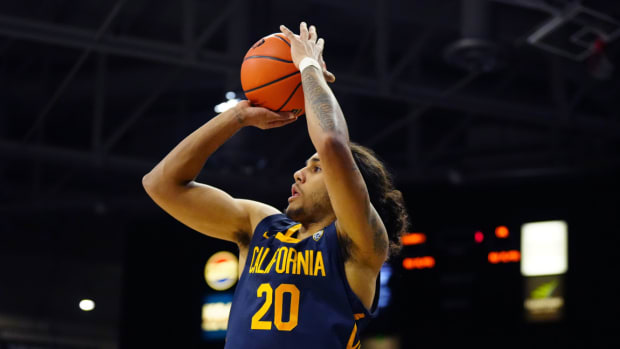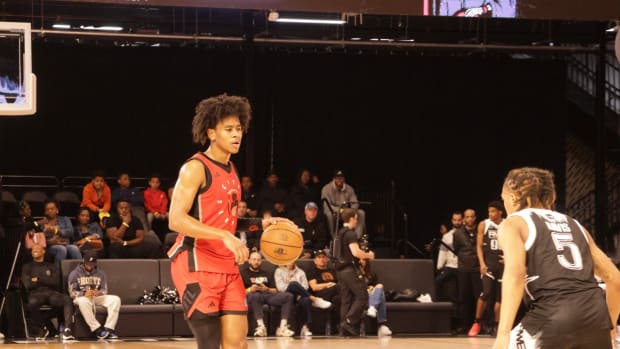How big heads became a part of college basketball culture

The big heads craze started at San Diego State, where Aztec fans used blowups of celebrities to distract opposing free throw shooters.
John W. McDonough /SI
Inspiration struck Conor Mongan in November 2002, while he was sitting on the purple, velour sofa in his apartment in the Mission Valley neighborhood of San Diego, Calif. He was watching a television news report about a court appearance by Michael Jackson when a close-up image of the pop star appeared on the screen. Mongan shuddered at Jackson's unsightliness, at his unnaturally pointy and scabby nose, his too-white skin and bug-eyed expression. Then he thought:
That's it! It's perfect!
His reaction requires some context. At the time, the 25-year-old Mongan was one of the ringleaders of the student section at San Diego State men's basketball games, a group later self-dubbed The Show. Though he stopped attending classes at San Diego State in 1999, Mongan remained one of The Show's figureheads, using his background in graphic design to create the T-shirts that fans wore during games. That November, Mongan had been pondering ways the group could better distract opposing free throw shooters. When Jackson's face popped up on Mongan's television, it triggered an aha moment: If he had been so stricken by Jackson's mug, Mongan thought, imagine how a free throw shooter would react.
Working out of a local Kinko's over the next few days, Mongan divided the image of Jackson into quarters using Photoshop and then printed each quarter on an 11x17 piece of paper. He then pieced the photo back together, adhered it to a 20x30 poster board, and cut the outline with scissors.
The Jackson big head made its first appearance at the Aztecs' Dec. 12 game at Long Beach State. At the largely empty Pyramid in Long Beach, Mongan positioned himself two rows behind one basket and waited. With 11:03 left in the first half, Long Beach State guard Darnell Thompson stepped to the line to attempt the game's first free throw. Just as Thompson set to shoot, Mongan held up the giant Jackson head and moved it from side to side. Thompson stopped, clearly startled, Mongan recalls, and then Thompson looked to the sideline, as if asking his coaches: Do I really have to shoot with that in my sightline?
PHOTO GALLERY: Big heads in college basketball
Thompson missed both free throws, and Mongan and the other members of The Show roared. "I knew we were on to something," Mongan says, and over the next three seasons he revealed more than a dozen new heads that featured Gene Simmons ("with a moveable red sock tongue"), Siegfried & Roy ("Roy's eyes were X'd out after he was mauled by that tiger") and David Hasselhoff ("before he got cool again").
In those early years, Mongan never envisioned that big heads would become so common in college basketball that it is now rare to find a student section without them. He did not foresee them joining foam fingers, rally towels and thundersticks among the great innovations in fandom, nor did he realize that his Michael Jackson head would spawn a multi-million dollar industry with a compelling large corporation vs. small startup storyline.
"I never looked at the heads as anything other than something to distract a shooter," Mongan says. "What has happened the last couple years, it has blown me away."
Like any cultural trend, it is difficult to trace the precise route the big heads took as they spread east across the country. One theory is that the nation embraced them in full around December 2005, when a picture of The Show appeared in ESPN the Magazine. In that photo, no less than nine heads are visible: Conan O'Brien, Larry King, Emilio Estevez, Chris Farley, Michael Moore, Lil Jon, Richard Simmons, Chuck Norris and "Aztec Joe" (a troll on a message board popular with members of The Show).
"I saw that photo and we talked about what the San Diego State students were doing and we decided to try it," says Craig Pintens, who in 2005 was the assistant athletic director for marketing at Marquette. He and other staffers created big heads of Mike Tyson (with his face tattoo), Brittany Spears (bald version), Blink 182 drummer Travis Barker (Mohawk included), and a life-sized version of Mini-Me from the Austin Powers movies. Those heads debuted at Marquette's Big East Conference opener against Connecticut and were a huge hit.
Marquette eventually found a local company -- JobNoggin, a job listings website -- to sponsor its heads, and renamed them "Big Noggins." JobNoggin's logo was placed on the back of all the heads. Later, the athletic department created an online poll where fans could vote on one of four potential heads to be revealed at each home game. A recent lineup consisted of Clint Dempsey, Ray Lewis, Colin Kaepernick and "Bill Clinton Photobomb." (Clinton won.) The winning noggin is unveiled during the first timeout of the second half and presented to the student section to the theme music from 2001: A Space Odyssey. Marquette's website also features a gallery of every head ever used (Total: 150) and the Golden Eagles' won-lost record with each head in attendance. (Charles Barkley's substantial noggin is an impressive 33-5; Gary Busey's is 8-7.)
Pintens, who now works at Oregon, says he once received a voicemail at 2 a.m. from a member of The Show. The caller, whose name Pintens could not recall, commented that Marquette had stolen San Diego State's idea. (He also inquired about an internship.) Says Pintens: "I called him back and told him that absolutely we stole their idea, but that we always credit San Diego State for being first."
More and more schools are producing their own heads, and, generally speaking, those are tamer than the heads devised by students. The most creative students do their research; they find embarrassing photos of opposing players on Twitter, Facebook and Instagram and make big heads out of them. They also deftly perpetuate stereotypes: Among the noggins at Marquette's game against rival Wisconsin earlier this season was one of Badgers coach Bo Ryan and an eerily similar-looking Grinch. "That was created by the students," says Kim Mueller, Marquette's assistant athletic director who now oversees the Big Noggin program. "Sometimes [the students] do things we can't back as an administration, but as long as it is not profane we allow it."
It is a safe bet that no athletic department would have endorsed many of The Show's most creative heads, including what Mongan considers his pièce de résistance: The three-year campaign mocking former Wyoming coach Steve McClain, known among Mountain West fans as "Rat face."
"The first one I did of McClain, I superimposed his head on a rat's body, gave him whiskers and teeth," Mongan says. "The players on the Wyoming bench saw it and were covering their faces with towels to hide their laughter." By McClain's final season (2006-07), several "Rat face" McClain heads were displayed whenever Wyoming played the Aztecs -- one featured him holding a glowing piece of cheese -- and members of The Show also held up giant cutouts of a rattrap and similar props. After one game, McClain flipped off The Show, Mongan says, and McClain's mother approached the group and expressed her disappointment with the "rat-ification" of her son.
McClain is now an assistant coach at Indiana, a school that has embraced the use of sanctioned big heads like few others. When Tom Crean moved from Marquette to Indiana in 2008, he brought the heads with him (figuratively speaking). Now, Indiana athletic department staffers hand out between 75 to 100 big heads before each game. At halftime, they move the heads from the north to the south end of Assembly Hall so that visitors are always shooting into a sea of big heads. At game's end, staffers stand at the exits closest to the student section and retrieve the heads.
"Last year, when we beat No. 1 Kentucky, we lost about 40-50 percent of our stock," says Mark Skirvin, Indiana's associate athletic director for marketing. "Kids were tearing them into pieces and throwing them in the air."
Indiana produces so many heads -- a local printer charges $75 apiece for the largest heads, which are mounted on foam board -- that there is a line item for them in the athletic department budget. "It's a significant cost but it has really caught on with our student fans," says Skirvin. "How long they will keep liking them is hard to say, but I don't think they are going anywhere for awhile."
Indiana does not make heads of its own players -- Crean doesn't want team members singled out -- but many schools do. Mongan considers that a bastardization of his idea. The only Aztec player to get his own big head in the early years of The Show was center Brian Carlwell, Mongan says, and that was made from a Halloween photo of Carlwell dressed as a vampire.
"The way it is now, it is more something people hold up to get on TV," Mongan says. "Like whatever broadcaster is calling the game, you hold up his head and the camera goes to you. Or, if your player scores, you hold up his head ... It is a little flattering that so many people copied us, but the true root of it now is different. I didn't see that happening."
He also failed to realize that there was money to be made.
*****
In April 2009, 23-year-old Bryan Price was nearing the end of his final year at Simpson College in Indianola, Iowa, when a friend, Steve Berrelleza, called to tell him that Lance Armstrong would be passing through Silver Springs, N.M., where Berrelleza lived, for the Tour of the Gila. Berrelleza said he felt like he should do something to mark Armstrong's appearance.
Price's response: Make Armstrong big heads.
Berrelleza loved the idea, and he went to a local printer and ordered 100, 12x18 Armstrong heads at a cost of $1 apiece and then stayed up the night before the race gluing them to cardboard. The next day, he sold them along the race route, finding the most success standing on a boulder next to Armstrong's parked tour bus. One of the biggest fans of the Armstrong heads was Armstrong himself. He autographed several of them and took a photo of himself and some fans holding them in front of their faces, which appeared in his 2009 book Comeback 2.0.
When Price heard about the popularity of the Armstrong heads, he experienced his own aha moment. "I was standing outside my apartment in Iowa and I realized that this could be a business," says Price, who earned a B.A. in Management and a minor in Marketing. "I couldn't believe no one else had thought of it."
After graduation, Price moved back into his parents' house in Phoenix, borrowed several thousand dollars from his father, a retired firefighter, and endeavored to create a business model and profit off the big head phenomenon. Working out of his parents' garage, he and a partner, Stas Chomokos, launched the company, Build-A-Head (and its website, buildahead.com) in March 2010.
In the first year, business was slow, and Price delivered pizzas and Chomokos waited tables to make ends meet. But Build-A-Head slowly gained traction as more and more people found its website. Their first break came when the Phoenix Suns ordered 2,000 heads (400 each of their starting five) to give away to fans during the 2010 West Conference Finals.
As Build-A-Head grew, Price began to see an almost infinite pool of products for what he calls "face cutouts." Why not key chains? Why not Christmas ornaments? He also devised a way to make disposable heads that were less costly to produce and could be sold for under $10. "My belief was that this had the potential to be large scale, not remain a garage operation," he says.
But a big hurdle remained: Build-A-Head needed to enter into licensing agreements with the various professional leagues. Without the licenses, Build-A-Head could still do promotions, like the one for the Suns in 2010 or the order of 5,000 units later filled for the New York Rangers, but the company couldn't sell big heads or key chains or ornaments of famous athletes directly to the public.
Early in 2012, Price says he contacted Steiner Sports, the New York-based memorabilia and marketing company, to assist him in negotiating with the professional leagues. Talks with the leagues were progressing, Price says, when an article about Build-A-Head appeared on CNBC's website. The day after the article's publication, Price says he got a call from Joe Esposito, the COO of Fathead, the Detroit-based company best known for selling life-sized wall graphics of athletes. Esposito informed Price that Fathead was moving into the big head business, and asked if Build-A-Head would be interested in becoming one of Fathead's printers. Price responded that he saw Build-A-Head as more than a printer.
A short time later, Price learned from Steiner Sports that Build-A-Head's attempt to gain licensing had failed. Then, in March, Fathead issued a press release announcing the launch of Fathead big heads. The release stated that Fathead would offer licensed big heads of professional athletes in the near future. "Fathead is owned by Dan Gilbert, who owns the Cleveland Cavaliers, and Build-a-Head is owned by a pizza delivery guy in Phoenix," says Price. "Who would you give licensing to?"
Price called Esposito and said he thought the companies could still work together. He told him that there was more to the business than just big heads. He detailed his plan for selling head key chains, head Christmas ornaments and more affordable big heads. Esposito was interested and asked Price to come to Fathead's headquarters. He added that Gilbert "has an affinity for entrepreneurs and has even been known to help out a company like [Build-A-Head]."
In May, Price travelled to Detroit with Chomokos. "We walked into the office and they had a big head of every employee next to their desks," Price says. "We noticed that one of the heads had been manufactured by Build-A-Head. [Chomokos] remembered getting the order and making it."
Price and Chomokos met with Esposito and CEO Patrick McInnis, and Price laid out his plans and talked extensively about how successful the fan giveaways had been, citing the deals he had struck with the Suns and Rangers. Esposito showed enthusiasm for the ideas, Price and Chomokos say, and the COO vowed to show a prototype keychain to his sales staff to gauge the interest of retailers.
Over the next few months, Price says he heard intermittently from Fathead executives. They would ask for more samples, suggest a fan giveaway they might partner on, and once asked if it was possible for Build-A-Head to change the packaging of one of its products. Weeks also passed when Price heard nothing. Eventually, Price says Fathead quoted him prices for the key chains and fan giveaway heads that were so low that Build-A-Head would have lost money on each item. A short time later, Chomokos asked to leave the company to pursue other ventures, and Price bought him out. He was essentially back where he started, alone with his great idea.
Fathead now owns a dominant share of the big head market, which McInnis, the CEO, credits to an employee who approached him while he was getting coffee one day early in 2012 and said: "Why not offer big fat heads?"
"We didn't put that much thought into it. We didn't do much market research," McInnis says. "It just felt right."
Every day since July 12, big heads have ranked among Fathead's top 5 daily sellers. "We are getting more orders now from arenas and teams," McInnis says. "Fathead big heads have caught on so quickly."
McInnis says Gilbert came into the Fathead offices and, upon seeing all the employees with big heads on their cubicles instead of nameplates, asked that Fathead produce heads for his employees at Quicken Loans and the Cavaliers. It was proof that Price was right: The scope of the big head market remains undefined.
"We are creating some [big heads] that can be worn on the head like a helmet, some that are already on sticks, and less expensive heads and even double-sided heads," McInnis says. He adds: "There have been other companies who have been doing [big heads] for awhile. But we made our heads obnoxiously big. We went a little bigger to go with our name and brand recognition and it has caught fire."
Build-A-Head and Price have moved on ... sort of. He has carved out a niche supplying heads to family and friends of participants in marathons, but he still hopes that Fathead will partner with him on something. He notes that Gilbert founded Bizdom, a nonprofit that assists entrepreneurs in Detroit and Cleveland. He wonders, half-jokingly, if he isn't worthy of some assistance too.
"After all, I'm the guy who saw the potential in big heads three years before any of Dan Gilbert's executives did," Price said.
*****
In 2009, Conor Mongan "retired" from The Show at the age of 32. All that meant was that he bought a season ticket in a different part of Viejas Arena for the 2009-10 season, but "it was still hard," he says. "I'd look at the [student section] and see them doing something and be like, 'I would do that differently.' But it was time to move on."
Before the 2010-11 season, Mongan distanced himself even further, relocating to Austin, where he operates a business that sets up photo booths at events. He remains a rabid Aztecs fan. "I am the only guy in Austin you'll see wearing an SDSU hat," he says.
As for the Michael Jackson big head, the first of its kind, it has survived, and now hangs above a dresser in the bedroom of Mongan's younger brother, Sean, in their childhood home in San Diego. If you stand close enough to the Jackson big head, and if you can bear to look, you will see more than a dozen names written all over Jackson's chalky face. Following a game early in the 2003-04 season, Mongan lined up with other San Diego State fans to get autographs from the team. The players and coaches sat at folding tables on the court at Viejas Arena, and Mongan went one by one and had them sign Jackson's face. Last in the line was Steve Fisher, the Aztecs' septuagenarian coach. When Mongan placed the Jackson head before Fisher, the coach sat back in his chair and "he laughed a little, kind of under his breath," Mongan says. There is little Fisher hasn't seen in his half century coaching basketball, and he hasn't lasted this long by shunning innovation.
Fisher looked up at Mongan, smiled, and then scribed his signature across Jackson's big forehead.
